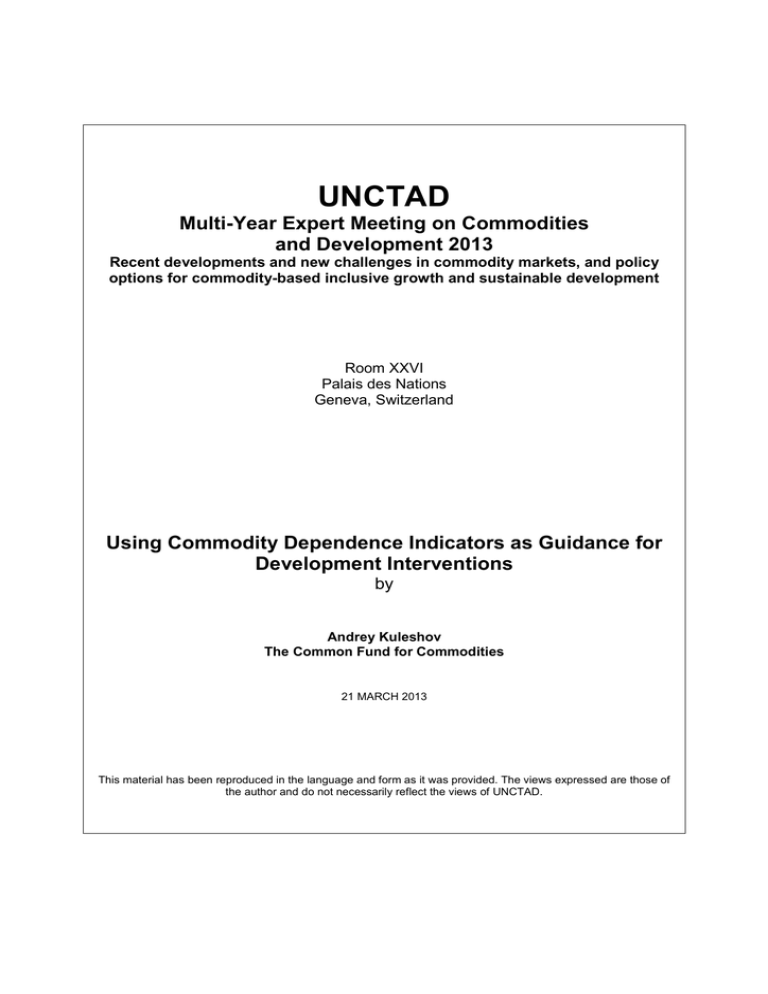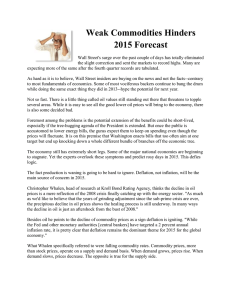UNCTAD Multi-Year Expert Meeting on Commodities and Development 2013
advertisement

UNCTAD Multi-Year Expert Meeting on Commodities and Development 2013 Recent developments and new challenges in commodity markets, and policy options for commodity-based inclusive growth and sustainable development Room XXVI Palais des Nations Geneva, Switzerland Using Commodity Dependence Indicators as Guidance for Development Interventions by Andrey Kuleshov The Common Fund for Commodities 21 MARCH 2013 This material has been reproduced in the language and form as it was provided. The views expressed are those of the author and do not necessarily reflect the views of UNCTAD. Using Commodity Dependence Indicators as Guidance for Development Interventions Andrey Kuleshov The Common Fund for Commodities Outline • Who is commodity dependent • Commodity dependence as symptom • Measuring commodity dependence • The way forward Is commodity dependence an issue? • Historical: US, Nordic, Malaysia growth took off from natural endowments • Current: Australia, Canada • Commodity developers: Brazil, Argentina and Thailand • Commodity-bound: we all know them CDDC or not CDDC? • Share of exports above benchmark (e.g. Gibbon, 2006) • CTOT explanation for differences (Cavalcantia et al. 2012) Is it effective to target commodities? • Few if any commodities (e.g. cocoa) are still dominated by exports from countries falling into the CDDC group (Burger, 2009) • Development problems better explained by domestic political and institutional variables? (Acemoglu et al 2004, Robinson et al, 2006) Practical approach EU-ACP: Commodity dependent if observe: •concentration of economic activity in one or more agricultural commodities; and •disproportionate share of population dependent on those sectors. Assumption: targeting commodity dependence in this context an effective way of allocating development resources EU: “...the term ‘CDDC’ is used for convenience [and] … should not be taken to suggest that a specific definition exists, or indeed should exist” Visualizing the question 100 50 0 At the high level of productivity an exceptional commodity endowment is required to be competitive. The higher the productivity, the more difficult for commodity sector to retain a dominant place Commodity persistence High share of commodities Structural vulnerabilities Costs Comm Low odity capital endow ment Cannot build up capital Reliance on commodities and vulnerability • Reliance on commodities to participate in global trade – rational economic choice if low stock of capital • Reliance on commodities brings a range of vulnerabilities: • • • • • Distorted investment Macroeconomic instabilities Governance difficulties Institutional problems etc • Gains from commodity production and trade offset by costs due to vulnerabilities. Cannot build capital base, stuck with low productivity. Persistent high share of commodities Commodity dependence • Commodity dependence is condition where a country is unable to convert its natural endowment into sustained economic development • Commodity dependence is the outcome and symptom of failures in addressing economic vulnerabilities associated with commodity production and trade If commodity dependence is a symptom, what are the underlying issues? Identify common determinants of growth given high share of commodities Analysis by Lee Robinson, leerobinsonuk@yahoo.co.uk • Panel study, 184 countries, 34 variables, average 1995 to 2009 • Principal component analysis of countries at different levels of commodity exports: >50%, >60%, >70% etc • Test if raising cutoff level changes first 4 PCs; found little change above 70% • Interpret 4 PCs at >70% and combine into index Commodity Vulnerability index • Component 1: Institutional Strength (-) • Resilience factors are very strong, finance system is healthy, growth is sustained and poverty is low • Component 2: Industrialised Fuel Exporting (-) • Poverty levels are low, growth and diversification patterns are occurring in manufacturing sectors and business sectors are strong, high fiscal reliance on commodities • Component 3: Concentration of economic activity (+) • Growth, though high and sustained, is narrow and occurring alongside vulnerabilities. More likely to be short lived growth accelerations • Component 4: Point Resource Growth, Vulnerability (+) • Low manufacturing exports, value added and vulnerabilities not offset by any resilience factors. % share vs CV index Positively correlated CV registers differences at lower % share Comparing the relathionships Manufacturing Exports (% of Exports) Fuel Exports (proportion of total Exports) y = -18.374x + 21.687 y = -85.399x + 85.721 R² = 0.1002 R² = 0.8887 30 y = -0.093x + 0.3748 R² = 0.0011 1.20 25 1.00 20 0.80 15 0.60 10 0.40 5 0.20 0 0 0.2 0.4 0.6 0.8 0.00 1 0 UN’s Human Development Index y = -0.957x + 1.1102 R² = 0.471 1.20 y = 1.8385x - 1.2702 R² = 0.1687 y = -0.8532x + 1.328 R² = 0.1537 0.2 0.4 0.6 0.8 1 Control of Corruption (index) 1.00 y = -5.015x + 4.7922 y = -4.2322x + 5.7263 R² = 0.5772 R² = 0.1688 5.0 0.80 4.0 0.60 3.0 0.40 2.0 0.20 1.0 0.00 0 0.2 0.4 0.6 0.8 1 0.0 0 0.2 0.4 0.6 0.8 1 Top 20 CV index Rank Country 1 2 3 4 5 6 7 8 9 10 11 12 13 14 15 16 17 18 19 20 Zimbabwe Gabon Côte d'Ivoire Burundi Nigeria Sudan Papua New Guinea Ethiopia Angola Afghanistan Congo DRC Libya Guinea-Bissau Congo Algeria Yemen Turkmenistan Cameroon Tajikistan Guinea Composite index of commodity dependence 0.0687 0.0552 0.0428 0.0387 0.0366 0.0349 0.0318 0.0299 0.0299 0.0281 0.0280 0.0274 0.0273 0.0273 0.0253 0.0238 0.0235 0.0232 0.0227 0.0204 Rank by commodity exports 67 13 53 24 6 10 7 30 1 69 9 15 12 4 8 2 31 19 44 16 Visualizing the differences Conclusions • Simple measures of commodity dependence as % share uninformative for practical purposes • Vulnerabilities create a feedback which eats up gains from commodity production and trade • A few vectors explain large part of differences in performance of countries with high share of commodities • Can construct an index using these vectors to capture country’s capacity to overcome commodity related vulnerabilities Thank you! eco@common-fund.org leerobinsonuk@yahoo.co.uk








